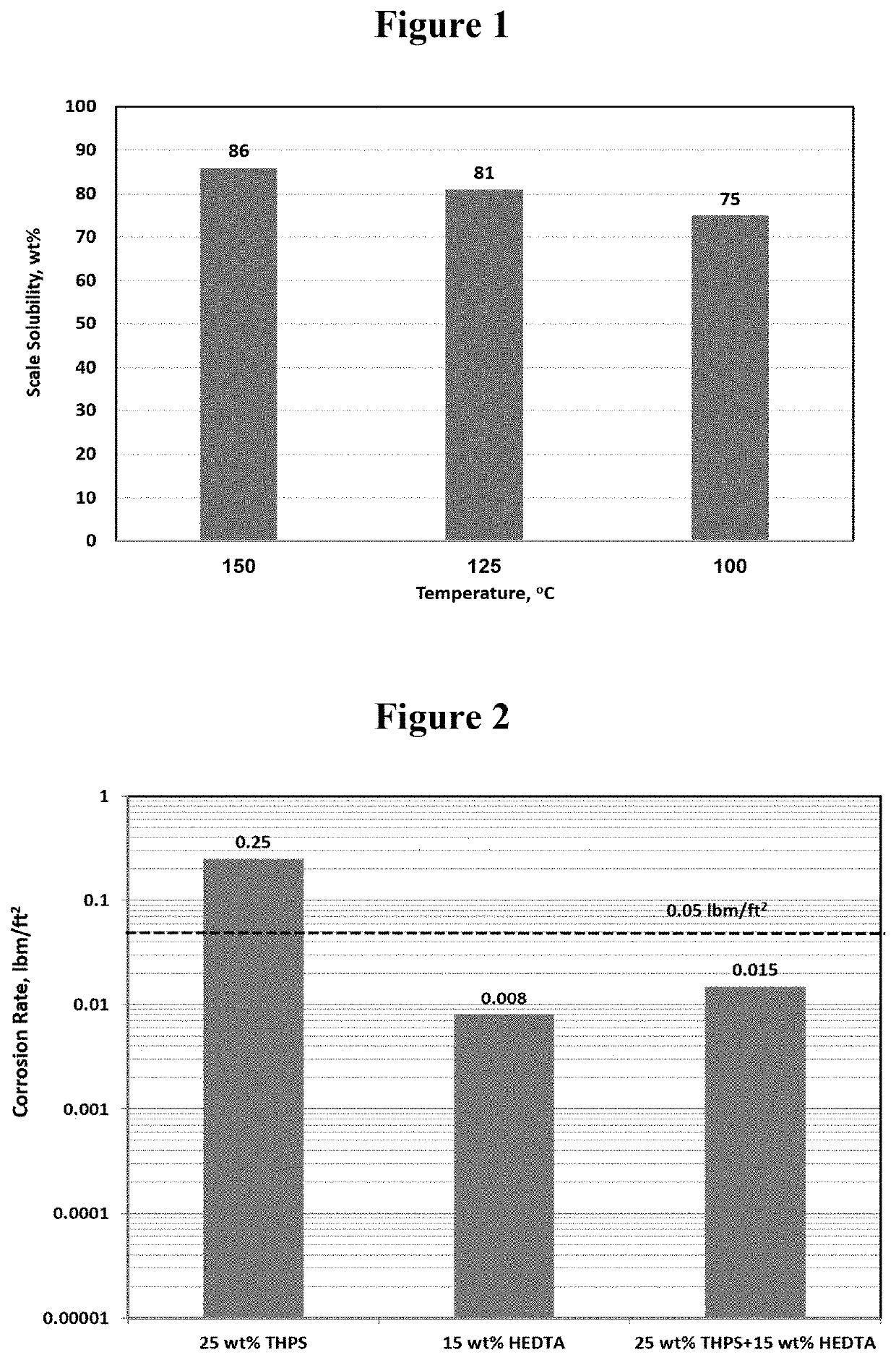Method for removing iron sulfide and calcium carbonate scale
a technology of calcium carbonate and iron sulfide, which is applied in the field of method for removing iron sulfide, can solve the problems of sulfide scale, formation damage, and accumulation of particulate iron sulfide as scal
- Summary
- Abstract
- Description
- Claims
- Application Information
AI Technical Summary
Benefits of technology
Problems solved by technology
Method used
Image
Examples
example 1
Materials and Methods:
[0083]Thermal stability experiments were conducted at high pressure-high temperature (HPHT) in a see-through-cell for 24 hours at temperatures up to 150° C. The pH of all formulations was 6.5 to reduce the corrosion of the well tubulars. Static corrosion tests were carried out at different temperature for 6 hours using HPHT autoclave reactor. The pressure was maintained at 1500 psi using a mixture of 10% CO2, 10% H2S, and 80% N2. Corrosion tests were performed using tubing and casing coupons. The corrosion rate was determined by measuring the weight of the coupons before and after the test. Static and dynamic solubility experiments were carried at HPHT autoclave reactor using scale samples for different soaking periods. The effects of fluids concentration and pH were investigated on the scale solubility. The tested iron, sulfide samples consist of 20 wt. % calcite, 40 wt. % pyrite (FeS2), and 40 wt. % pyhrottite (FeS). Also, core-flooding experiments were perfo...
example 2
Core-Flooding Experiments:
[0084]Two Indiana limestone cores were used to investigate the compatibility of the introduced formulation with the reservoir rock. The cores properties before and after core-flooding are listed in Table 1. The first formulation, 25 wt. % THPS caused damage to the core because the reaction of THPS with calcium carbonate from the rock precipitated calcium sulfate scale crustal that plugged the core pore throat and reduced the permeability. The second formulation contained 25 wt. % THPS and 15 wt. % HEDTA, enhanced the core permeability from 65 to 85 md, which>means no scale precipitations occurred in this case. HEDTA chelating agent prevented the precipitation of calcium sulfate because it chelated the calcium from the rock and solution and prevented its interaction with THPS. From these two experiments, we can conclude that THPS / HEDTA formulation is safe to remove iron sulfide scale from the rock samples and also from the tubing without the risk of precipit...
example 3
Scale Removal Experiments:
[0086]Scale solubility was performed at using different combinations of THPS and HEDTA chelating agent. Concentrations from 10 to 30 wt. % of each THPS and HEDTA were tested and the optimum concentrations of the composition tested on scale sample contains 25 wt. % THPS and 15 wt. % HEDTA. Table 3 shows the solubility results for different composition comprising varying amount of THPS and HEDTA at 150° C. The test duration was 24 hours. Very little increase in scale solubility was observed after 24 hrs. Also, the optimum formulation was tested at 100 and 125° C. and the results are shown in FIG. 1. Increasing the temperature enhanced the dissolution of iron sulfide scale, which gives an option of heating the fluid under pressure at the surface to expedite the scale removal process in the field. FIG. 2 shows the corrosion results at 150° C. in the absence of corrosion inhibitor indicating the optimal composition is not corrosive at 150° C. without adding corr...
PUM
 Login to View More
Login to View More Abstract
Description
Claims
Application Information
 Login to View More
Login to View More - R&D
- Intellectual Property
- Life Sciences
- Materials
- Tech Scout
- Unparalleled Data Quality
- Higher Quality Content
- 60% Fewer Hallucinations
Browse by: Latest US Patents, China's latest patents, Technical Efficacy Thesaurus, Application Domain, Technology Topic, Popular Technical Reports.
© 2025 PatSnap. All rights reserved.Legal|Privacy policy|Modern Slavery Act Transparency Statement|Sitemap|About US| Contact US: help@patsnap.com

